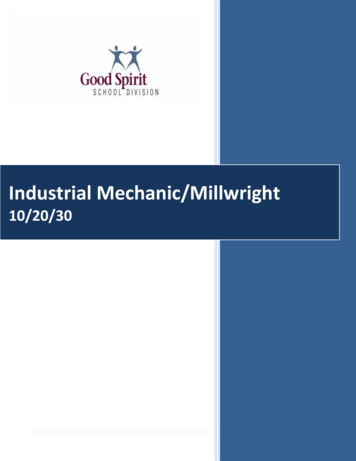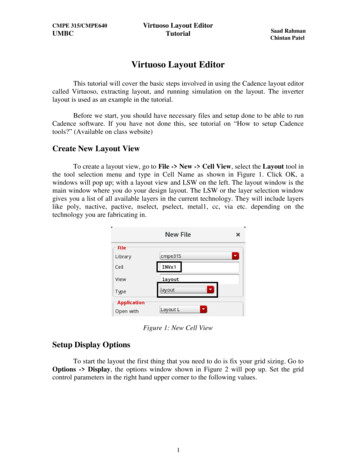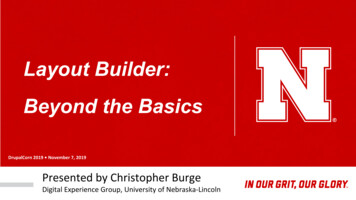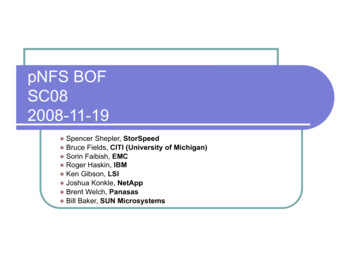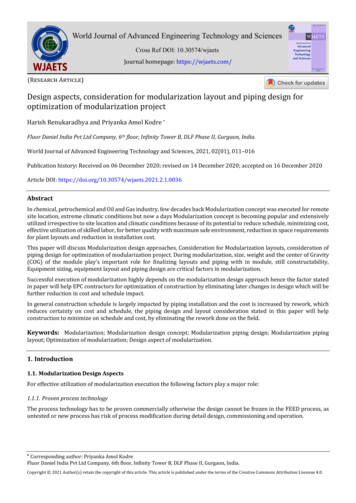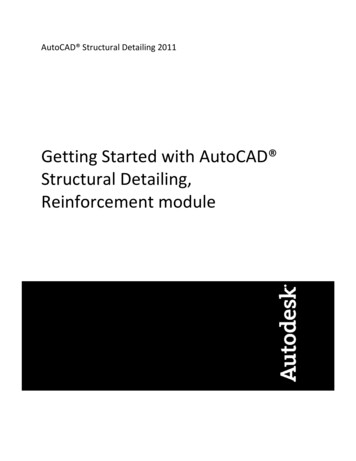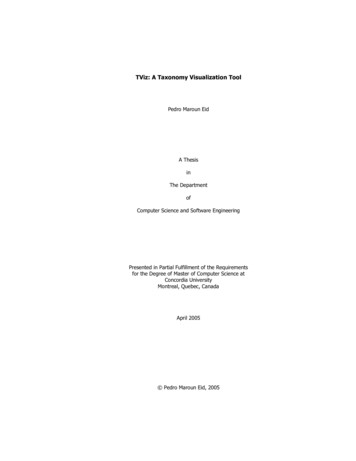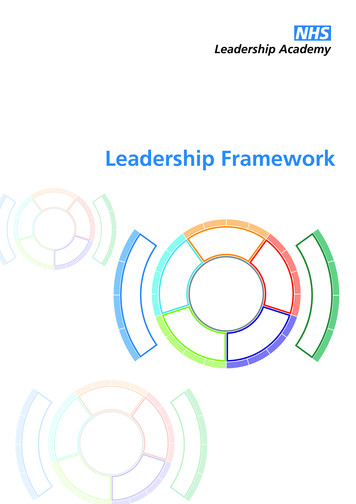
Transcription
Leadership AcademyLeadership Framework
2011 NHS Leadership Academy. All rights reserved.The Leadership Framework is published on behalf of the NHS Leadership Academy by NHS Institute forInnovation and Improvement, Coventry House, University of Warwick Campus, Coventry, CV4 7AL.Publisher: NHS Institute for Innovation and Improvement, Coventry House, University of Warwick Campus,Coventry, CV4 7AL.This publication may be reproduced and circulated free of charge for non-commercial purposes only by andbetween NHS-funded organisations in England, Scotland, Wales and Northern Ireland staff, and their relatednetworks and officially contracted third parties. This includes the right to reproduce, distribute and transmit thispublication in any form and by any means, including e-mail, photocopying, microfilming, and recording. Noother use may be made of this publication or any part of it except with the prior written permission andapplication for which should be in writing and addressed to the Director of Leadership (and marked ‘re.permissions’). Written permission must always be obtained before any part of this publication is stored in aretrieval system of any nature, or electronically. Reproduction and transmission of this publication must beaccurate, must not be used in any misleading context and must always be accompanied by this Copyright Notice.Warning: Unauthorised copying, storage, reproduction, adaptation or other use of this publication or any part ofit is strictly prohibited. Doing an unauthorised act in relation to a copyright work may give rise to civil liabilitiesand criminal prosecution.The Clinical Leadership Competency Framework was created with the agreement of the NHS Institute forInnovation and Improvement and the Academy of Medical Royal Colleges from the Medical LeadershipCompetency Framework which was created, developed and is owned jointly by the NHS Institute for Innovationand Improvement and the Academy of Medical Royal Colleges.NHS Institute for Innovation and Improvement and Academy of Medical Royal Colleges (2010) MedicalLeadership Competency Framework, 3rd edition, Coventry: NHS Institute for Innovation and Improvement. NHS Institute for Innovation and Improvement and Academy of Medical Royal Colleges 2010
Table of ContentsPageForeword5The Leadership Framework6Application of the Leadership Framework111. Demonstrating Personal Qualities1.1 Developing Self Awareness1.2 Managing Yourself1.3 Continuing Personal Development1.4 Acting with Integrity13141516172. Working with Others2.1 Developing Networks2.2 Building & Maintaining Relationships2.3 Encouraging Contribution2.4 Working within Teams19202122233. Managing Services3.1 Planning3.2 Managing Resources3.3 Managing People3.4 Managing Performance25262728294. Improving Services4.1 Ensuring Patient Safety4.2 Critically Evaluating4.3 Encouraging Improvement and Innovation4.4 Facilitating Transformation31323334355. Setting Direction5.1 Identifying the Contexts for Change5.2 Applying Knowledge and Evidence5.3 Making Decisions5.4 Evaluating Impact37383940416. Creating the Vision6.1 Developing the Vision for the Organisation6.2 Influencing the Vision of the Wider Healthcare System6.3 Communicating the Vision6.4 Embodying the Vision43444546477. Delivering the Strategy7.1 Framing the Strategy7.2 Developing the Strategy7.3 Implementing the Strategy7.4 Embedding the Strategy4950515253Acknowledgements55Relevant reading57Appendix I: The Knowledge and Skills Framework (KSF)60Appendix II: Tables combining the indication of behaviours at different61leadership stages from each domainLeadership Framework3
ForewordI am delighted to introduce the NHS Leadership Framework; it provides a single overarching framework forthe leadership development of all staff in health and care, irrespective of discipline, role or function.It is underpinned by a consistent set of guiding principles, contained in the NHS Constitution, which reflectthe values of health and care staff. It therefore represents the foundation of leadership behaviour for staffthroughout the NHS, to support all staff to improve quality for our patients.This is a unique period in the NHS and a time of significant change for health and care services in England,with an unprecedented level of responsibility being devolved to frontline staff. Building on our successes aswe design the future requires bold and thoughtful leadership, rethinking how we work, challenging currentpractice and thinking outside of our own organisational and professional interests.It will be imperative that frontline clinicians and the wider workforce have the leadership knowledge, skillsand behaviours to drive radical service redesign and improvement. This will involve working in collaborationacross health systems, in developing new models of care, and further developing the skills of the entireworkforce. The ability to influence and manage change at the frontline will be central to delivering this. Thereis no doubt that we must continue to develop the leadership capability within the system. It is on this basisthat the Leadership Framework has been designed.Based on research and created through extensive consultation, the Leadership Framework has been tailoredto the specific needs and environment of the NHS, and is applicable to all staff at any stage of their career. Itsets out the expectations of leaders at every level of our system and provides guidance to those whocommission leadership development.The National Leadership Council (NLC) has led this work and I would like to thank everyone who hascontributed to the development of the NHS Leadership Framework.Sir David NicholsonNHS Chief ExecutiveLeadership Framework5
The Leadership FrameworkIntroductionThe Leadership Framework sets out the standard for leadership to which all staff in health and care shouldaspire. It is based on the concept that leadership is not restricted to people who hold designated leadershiproles and where there is a shared responsibility for the success of the organisation, services or care beingdelivered. Acts of leadership can come from anyone in the organisation and as a model it emphasises theresponsibility of all staff in demonstrating appropriate behaviours, in seeking to contribute to the leadershipprocess and to develop and empower the leadership capacity of colleagues1.Health and care staff train and work in many settings. Fundamental to development of the LeadershipFramework was a desire to build on existing leadership frameworks and create a single overarchingframework that provides a common language and approach to leadership development for all staff groupsirrespective of discipline, role, function or whether they work in the NHS, the independent or other sector. Inthe NHS it sets the foundation of leadership behaviours for all staff and will help them to understand theirprogression as a leader.The Leadership Framework has been developed by the National Leadership Council after extensive researchand consultation with a wide cross section of staff, patients, professional bodies and academics. Thoseconsulted embraced the concept of a single framework because it affords a common and consistentapproach to professional and leadership development based on shared values and beliefs which areconsistent with the principles and values of health and care staff and the NHS Constitution2.The Clinical Leadership Competency Framework and the Medical Leadership Competency Framework are alsoavailable to specifically provide staff with clinically based examples in practice and learning and developmentscenarios across the five core domains shared with the Leadership Framework.61NHS Institute for Innovation and Improvement and Academy of Medical Royal Colleges (2009) Shared Leadership:Underpinning of the MLCF. NHS Institute for Innovation and Improvement: Coventry2Department of Health (2010) The NHS Constitution: the NHS belongs to us all. The NHS Constitution can be accessed es/NHSConstitution/Pages/Overview.aspxLeadership Framework
The National Health Service (NHS) principles and valuesThe NHS Constitution establishes the principles and values of the NHS in England. The Constitution setsout rights to which patients, public and staff are entitled, and pledges which the NHS is committed toachieve, together with responsibilities which the public, patients and staff owe to one another to ensurethat the NHS operates fairly and effectively.1. The NHS provides a comprehensive service, available to all irrespective of gender, race, disability, age,sexual orientation, religion or belief.2. Access to NHS services is based on clinical need, not an individual’s ability to pay.3. The NHS aspires to the highest standards of excellence and professionalism – in the provision of highquality care that is safe, effective and focused on patient experience.4. NHS services must reflect the needs and preferences of patients, their families and their carers.5. The NHS works across organisational boundaries and in partnership with other organisations in theinterest of patients, local communities and the wider population.6. The NHS is committed to providing best value for taxpayers’ money and the most effective, fair andsustainable use of finite resources.7. The NHS is accountable to the public, communities and patients that it serves.These seven key principles guide the NHS in all it does and they are underpinned by the following corevalues. Patients, public and staff have helped develop this expression of values that inspire passion in theNHS and should guide it in the 21st century.The NHS values1 provide common ground for co-operation to achieve shared aspirations:Respect and dignityCommitment to quality of careCompassionImproving livesWorking together for patientsEveryone counts.Underpinning leadership principles of the Leadership FrameworkPeople understand the term ‘leadership’ in many different ways. Perhaps the most common stereotypic ideais of the individual, powerful, charismatic leader with followers clearly in subordinate roles. Such situations doexist but are quite limited, rather outdated and by the very rarity of charismatic qualities make it a poor modelfor leadership development. This way of thinking tends to focus on the individual as a leader rather than theprocesses of leadership.A more modern conceptualisation sees leadership as something to be used by all but at different levels.This model of leadership is often described as shared, or distributed, leadership and is especially appropriatewhere tasks are more complex and highly interdependent – as in healthcare. It is a universal model such thatall staff can contribute to the leadership task where and when their expertise and qualities are relevant andappropriate to the context in which they work. Not everyone is necessarily a leader but everyone cancontribute to the leadership process by using the behaviours described in the five core domains of theLeadership Framework: demonstrating personal qualities, working with others, managing services, improvingservices and setting direction.Leadership Framework7
As a model it emphasises the responsibility of all staff, in demonstrating appropriate behaviours, to seek tocontribute to the leadership process and to develop and empower the leadership capacity of colleagues.The final two domains of the Leadership Framework, creating the vision and delivering the strategy, recognisethat a relatively small group of people do hold designated senior positional roles, and are required to act asleaders in formal hierarchical positions. These two domains therefore focus more on the contribution ofindividual leaders rather than the general leadership process.Evolution of the Leadership FrameworkThe Leadership Framework has been designed to build on learning of the internationally recognised best practicestandards for leadership development. It was also informed by analysis of existing NHS leadership data and areview of contemporary leadership literature. The Leadership Qualities Framework (LQF)4. The LQF 360 tool has been used extensively by staff in roles aboveand beyond the executive population that the original LQF research was based upon. The Leadership Frameworkaddresses this by describing leadership behaviours for all staff depending on their role and the context in whichthey work. The Medical Leadership Competency Framework (MLCF)5. Jointly developed by The Academy of Medical RoyalColleges and the NHS Institute for Innovation and Improvement, the MLCF describes the leadershipcompetencies doctors need to become more actively involved in the planning, delivery and transformation ofservices for patients. It applies to all medical students and doctors throughout their careers. The Clinical Leadership Competency Framework (CLCF)6. The NLC commissioned the NHS Institute to test theleadership competencies in the MLCF to see whether they could be applied to all healthcare professionals.These have been endorsed by the clinical professions and will be progressively embedded within professionalregulation and into education and utenessIntellectualflexibilitySeizingthe futurePersonalQualitiesDrive forresultsLeading changethrough peopleSelf beliefSelf awarenessSelf managementDrive for improvementPersonal integrityCollaborativeworkingHolding toaccountEffectiveand strategicinfluencingEmpoweringothersDelivering theServiceLQFCLCF and MLCFLeadership FrameworkThe five domains of the CLCF and the MLCF were informed by the LQF, and are shared with the core five domainsof the Leadership Framework to create a single overarching leadership framework.84NHS Institute for Innovation and Improvement (2005) NHS Leadership Qualities Framework http://www.nhsleadershipqualities.nhs.uk5NHS Institute for Innovation and Improvement and Academy of Medical Royal Colleges (2010) Medical Leadership CompetencyFramework. 3rd ed. NHS Institute for Innovation and Improvement: Coventry.6Department of Health (2011). Clinical Leadership Competency Framework. NHS Institute for Innovation and Improvement: Coventry.Leadership Framework
Design and structure of the Leadership FrameworkThe needs of the people who use services have always been central to healthcare. However, if we are going totransform services, acting on what really matters to patients and the public is essential and involves the activeparticipation of patients, carers, community representatives, community groups and the public in how services areplanned, delivered and evaluated7.Delivering services to patients, service users, carers and the public is therefore at the heart of the LeadershipFramework. All staff work hard to improve services for people.The Leadership Framework is comprised of seven domains. Within each domain there are four categories calledelements and each of these elements is further divided into four descriptors. These statements describe theleadership behaviours which are underpinned by the relevant knowledge, skills and attributes all staff should beable to demonstrate radiating out from those of the individual to those within the wider system.We use the word ‘patient’ throughout the Leadership Framework to generically cover patients, service users,and all those who receive healthcare. Similarly, the word ‘other’ is used to describe all colleagues from anydiscipline and organisation, as well as patients, service users, carers and the public.The five core domains are:1. Demonstrating personal qualities - effective leadership requires individuals to draw upon theirvalues, strengths and abilities to deliver high standards of service. This requires them todemonstrate effectiveness in developing self awareness, managing themselves, continuingpersonal development and acting with integrity.2. Working with others – effective leadership requires individuals to work with others in teams andnetworks to deliver and improve services. This requires them to demonstrate effectiveness indeveloping networks, building and maintaining relationships, encouraging contribution, andworking within teams.3. Managing services - effective leadership requires individuals to focus on the success of theorganisation(s) in which they work. This requires them to be effective in planning, managingresources, managing people and managing performance.4. Improving services - effective leadership requires individuals to make a real difference to people’shealth by delivering high quality services and by developing improvements to services.This requires them to demonstrate effectiveness in ensuring patient safety, critically evaluating,encouraging improvement and innovation and facilitating transformation.5. Setting direction - effective leadership requires individuals to contribute to the strategy andaspirations of the organisation and act in a manner consistent with its values. This requires themto demonstrate effectiveness in identifying the contexts for change, applying knowledge andevidence, making decisions, and evaluating impact.7Patient and Public Engagement, Department of Health (2009) Putting Patients at the Heart of Care: The Vision for Patient and PublicEngagement in Health and Social Care. www.dh.gov.uk/ppeLeadership Framework9
There are two additional domains which apply particularly but not exclusively to individuals in seniorpositional leadership roles.6. Creating the vision - those in senior positional leadership roles create a compelling vision for thefuture, and communicate this within and across organisations. This requires them to demonstrateeffectiveness in developing the vision for the organisation, influencing the vision of the widerhealthcare system, communicating the vision and embodying the vision.7. Delivering the strategy – those in senior positional leadership roles deliver the strategic vision bydeveloping and agreeing strategic plans and ensuring that these are translated into achievableoperational plans. This requires them to demonstrate effectiveness in framing the strategy,developing the strategy, implementing the strategy and embedding the strategy.The leadership contextThe application and opportunity to demonstrate leadership will differ and the context in which competencecan be achieved will become more complex and demanding with career progression. We have therefore usedfour stages to describe this and to help staff understand their progression and development as a leader.They are:Stage 1 Own practice/immediate team - is about building personal relationships with patients andcolleagues, often working as part of a multi-disciplinary team. Staff need to recognise problems and workwith others to solve them. The impact of the decisions staff take at this level will be limited in terms of risk.Stage 2 Whole service/across teams - is about building relationships within and across teams, recognisingproblems and solving them. At this level, staff will need to be more conscious of the risks that their decisionsmay pose for self and others for a successful outcome.Stage 3 Across services/wider organisation - is about working across teams and departments within thewider organisation. Staff will challenge the appropriateness of solutions to complex problems. The potentialrisk associated with their decisions will have a wider impact on the service.Stage 4 Whole organisation/healthcare system - is about building broader partnerships across and outsidetraditional organisational boundaries that are sustainable and replicable. At this level leaders will be dealingwith multi-faceted problems and coming up with innovative solutions to those problems. They may lead at anational/international level and would be required to participate in whole systems thinking, finding new waysof working and leading transformational change. Their decisions may have significant impact on thereputation of the organisation/system and outcomes and would be critical to the future.10Leadership Framework
Application of the LeadershipFramework and supporting toolsThe Leadership Framework sets out the standard for leadership to which all staff in health and care shouldaspire. It is intended for use as a developmental framework and there are many ways it can be applied, forexample: To raise awareness that effective leadership is needed across the whole organisation To underpin a talent management strategy As part of an existing leadership development programme To inform the design and commissioning of training and development programmes To develop individual leadership skills As part of team development To enhance existing appraisal systems To inform an organisation’s recruitment and retention processes.The Leadership Framework is structured to assist the user to understand how they relate to each of the sevendomains. Staff will exhibit a range of leadership behaviours across these seven domains dependent on thecontext in which they operate. To improve the quality and safety of health and care services, it is essential thatstaff are competent in each of the five core leadership domains: demonstrating personal qualities, workingwith others, managing services, improving services and setting direction. The two other domains of theLeadership Framework, creating the vision and delivering the strategy, focus more on the role andcontribution of individual leaders.To help users understand and apply the Leadership Framework each domain is divided into four elements andeach of these elements is further divided into four descriptive statements which describe the behaviours allstaff should be able to demonstrate.To assist users there are a number of indicators across a variety of work place situations which illustrate the typeof activity staff could be demonstrating relevant to each element and stage as well as examples of behaviours ifthey are not. These indicators are intended to be examples and only apply to part of each element.The CLCF and MLCF are also available to specifically provide staff with clinically based examples and learningand development scenarios across the five core domains shared with the Leadership Framework.Supporting toolsA self assessment and 360 feedback tool support the Leadership Framework; in addition an onlinedevelopment module signposts development opportunities for each of the seven domains. The 360 is apowerful tool to help individuals identify where their leadership strengths and development needs lie.The process includes getting confidential feedback from line managers, peers and direct reports. As a result, itgives an individual an insight into other people’s perceptions of their leadership abilities and behaviour.To assist with integrating the competencies into postgraduate curriculaand learning experiences, there is the LeAD e-learning resource. LeAD isa range of more than 50 short e-learning sessions that support theknowledge base of the MLCF and the CLCF. Examples and contextsrange across various different fields and specialties, all aimed at improving patient care and services.LeAD addresses how clinicians can develop their leadership contribution in clinical settings. Originally it wasLeadership Framework11
produced to support medical trainees, however new sessions are being added to broaden out the learning toall clinical professions. In addition the resources section of each session includes examples of the MLCF andCLCF in practice and ideas for further development, useful to both the individual learner and also to trainersor supervisors.LeAD is available on the National Learning Management System and through e-Learning for Healthcare(www.e-lfh.org.uk/LeAD).How the Leadership Framework fits with other career and skills based frameworksThe Leadership Framework is designed to be used in conjunction with career or skills based frameworks likethe Nursing Careers Framework and the NHS Knowledge and Skills Framework (KSF).For example, a line manager may use the KSF to support an appraisal and development review whereas staffmay use the Leadership Framework to understand where their leadership strengths and development needslie - for further information on the KSF see Appendix I on page 60.The full Leadership Framework follows, complete with examples in practice and work-placeindicators to demonstrate the practical application of the framework. Please note the indicators areexamples only and intended as a guide across part of the relevant element.12Leadership Framework
1. Demonstrating Personal QualitiesEffective leadership requires individuals to draw upon their values, strengths and abilities to deliver highstandards of service. To do so, they must demonstrate effectiveness in: Developing Self Awareness Managing Yourself Continuing Personal Development Acting with Integrity.Leadership Framework13
1. Demonstrating Personal Qualities1.1 Developing Self AwarenessLeaders develop self awareness: being aware of theirown values, principles and assumptions and by beingable to learn from experiences.Competent leaders: Recognise and articulate their own values andprinciples, understanding how these may differ fromthose of other individuals and groups Identify their own strengths and limitations, theimpact of their behaviour on others, and the effect ofstress on their own behaviour Identify their own emotions and prejudices andunderstand how these can affect their judgment andbehaviour14Stage 1Own practice/immediate teamStage 2Whole service/across teamsStage 3Across services/wider organisationReflects on their interactions with a wide and diverse range of individuals and groups fromwithin and beyond their immediate service/organisation. Challenges and refreshes ownvalues, beliefs, leadership styles and approaches. Overtly role models the giving andreceiving of feedback.Stage 4Whole organisation/healthcare systemContextual Indicators Obtain, analyse and act on feedback from a variety ofsources.Uses sophisticated tools and sources to continuously learn about their leadership impact inthe wider health and care community and improve their effectiveness as a senior leader.Understands how pressures associated with carrying out a high profile role impact on themand their performance.Reflects on how factors such as own values, prejudices and emotions influence theirjudgement, behaviour and self belief. Uses feedback from appraisals and other sources toconsider personal impact and change behaviour. Understands personal sources of stress.Appreciates the impact they have on others and the impact others have on them.Routinely seeks feedback and adapts their behaviour appropriately.Leadership Framework
1. Demonstrating Personal Qualities1.2 Managing YourselfLeaders manage themselves: organising andmanaging themselves while taking account of theneeds and priorities of others.Competent leaders: Manage the impact of their emotions on theirbehaviour with consideration of the impact onothers Are reliable in meeting their responsibilities andcommitments to consistently high standards Ensure that their plans and actions are flexible, andtake account of the needs and work patterns ofothersStage 1Own practice/immediate teamPlans and manages own time effectively and fulfils work requirements and commitmentsto a high standard, without compromising own health and wellbeing. Remains calm andfocused under pressure.Stage 2Whole service/across teamsEnsures that own work plans and priorities fit with the needs of others involved indelivering services. Demonstrates flexibility and sensitivity to service requirements andremains assertive in pursuing service goals.Stage 3Across services/wider organisationStage 4Whole organisation/healthcare systemContextual Indicators Plan their workload and activities to fulfil workrequirements and commitments, withoutcompromising their own health.Successfully manages a range of personal and organisational demands and pressures.Demonstrates tenacity and resilience. Overcomes setbacks where goals cannot be achievedand quickly refocuses. Is visible and accessible to others.Remains focused on strategic goals when faced with competing and, at times, conflictingdemands arising from differing priorities. Identifies where they need to personally getinvolved to achieve the most benefit for the organisation and wider healthcare system.Leadership Framework15
1. Demonstrating Personal Qualities1.3 Continuing Personal DevelopmentLeaders actively engage in continuing personaldevelopment: learning through participating incontinuing professional development and fromexperience and feedback.Competent leaders: Actively seek opportunities and challenges forpersonal learning and development Acknowledge mistakes and treat them as learningopportunities Participate in continuing professional developmentactivities Change their behaviour in the light of feedback andreflection.16Stage 1Own practice/immediate teamTakes responsibilities for own personal development and seeks opportunities for learning.Strives to put learning into practice.Stage 2Whole service/across teamsPuts self forward for challenging assignments and projects which will develop strengthsand address development areas.Stage 3Across services/wider organisationActs as an exemplar for others in managing their continuous personal development.Facilitates the development of a learning culture.Stage 4Whole organisation/healthcare systemContextual IndicatorsDevelops through systematically scanning the external environment and exploring leadingedge thinking and best practice. Applies learning to build and refresh the service.Treats challenge as a positive force for improvement.Leadership Framework
1. Demonstrating Personal Qualities1.4 Acting with IntegrityLeaders act with integrity: behaving in an open,honest and ethical manner.Competent leaders: Uphold personal and professional ethics and values,taking into account the values of the organisationand resp
The Leadership Framework sets out the standard for leadership to which all staff in health and care should aspire. It is based on the concept that leadership is not restricted to people who hold designated leadership roles and where there is a shared responsibility for the success of the organisation, services or care being delivered.
